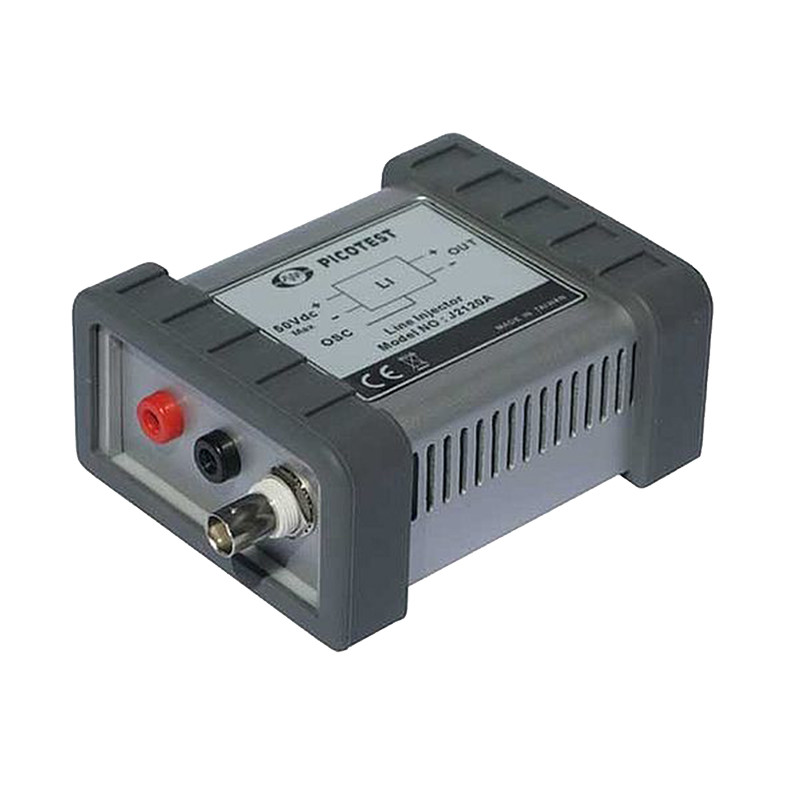

Jūs turite būti prisijungę
Category


Nuotraukos yra skirtos tik informaciniams tikslams. Peržiūrėkite produkto specifikaciją
please use latin characters
While the injection transformer is a very wideband adapter, it is not useful for measuring ripple rejection (PSRR) of a power supply or even an op-amp. This is because the attributes that make the injection transformer perform so well also result in a transformer that is intolerant of DC current. Even very small DC currents (5mA or less) can greatly reduce the signal capacity or even totally saturate the transformer. For this reason, the Picotest line injector (J2120A) is another essential test adapter.
The line injector allows the input DC supply voltage to be modulated by the network analyzer source signal, as in the case of a PSRR measurement. The line injector must be capable of a frequency range well below the AC line frequency and at least above the control loop bandwidth of the circuit being tested.
The line injector is only capable of sourcing current, so that the output amplitude can be significantly impacted by the operating current and the total storage capacitance at the load. The Bode-100 network analyzer has a very high selectivity so distortion at the output of the line injector generally does not influence the measurement. Again, this is a small signal injector, so the oscillator signals should be kept as small as possible above the noise floor. As a guide, try to keep the input signal amplitude below 50mVpp (-20dBm). In some cases we want to attenuate the source signal even further, and so we have included the attenuators in the injector kits. Some analyzers, such as the Omicron-Lab-Lab Bode-100 allow shaping the injection amplitude as a function of frequency, which helps optimize the signal level.
The line injector can also be used in conjunction with a current probe to measure the input impedance of a power supply. The input impedance of a switching power supply or regulator is negative, which is a stability concern when combined with an EMI filter, making the measurement an important part of the design, analysis and verification process. The current probe must be set for 1A/V or the results need to be scaled accordingly for different settings.
Key features:
Rated data:
| Max. DC input voltage | 50V |
|---|---|
| Max. continuous current | 5A |
| Max voltage drop | 3.25V DC |
| 3dB Frequency response | 15Hz…5MHz |
| Useable frequency response | 10Hz…10MHz |
| Recommended injection signal | -20…10dBm |
| Temperature range | 0…50°C |
| Maximum altitude | 1850m |
| Dimensions | 109x90x51mm |
| Weight | Banana, MOD – BNC |
| Input | Banana |
Connection diagram:

Ar Jūs domina šis produktas? Ar Jums reikia papildomos informacijos ar individualaus pasiūlymo?
tu turi būti prisijungęs
While the injection transformer is a very wideband adapter, it is not useful for measuring ripple rejection (PSRR) of a power supply or even an op-amp. This is because the attributes that make the injection transformer perform so well also result in a transformer that is intolerant of DC current. Even very small DC currents (5mA or less) can greatly reduce the signal capacity or even totally saturate the transformer. For this reason, the Picotest line injector (J2120A) is another essential test adapter.
The line injector allows the input DC supply voltage to be modulated by the network analyzer source signal, as in the case of a PSRR measurement. The line injector must be capable of a frequency range well below the AC line frequency and at least above the control loop bandwidth of the circuit being tested.
The line injector is only capable of sourcing current, so that the output amplitude can be significantly impacted by the operating current and the total storage capacitance at the load. The Bode-100 network analyzer has a very high selectivity so distortion at the output of the line injector generally does not influence the measurement. Again, this is a small signal injector, so the oscillator signals should be kept as small as possible above the noise floor. As a guide, try to keep the input signal amplitude below 50mVpp (-20dBm). In some cases we want to attenuate the source signal even further, and so we have included the attenuators in the injector kits. Some analyzers, such as the Omicron-Lab-Lab Bode-100 allow shaping the injection amplitude as a function of frequency, which helps optimize the signal level.
The line injector can also be used in conjunction with a current probe to measure the input impedance of a power supply. The input impedance of a switching power supply or regulator is negative, which is a stability concern when combined with an EMI filter, making the measurement an important part of the design, analysis and verification process. The current probe must be set for 1A/V or the results need to be scaled accordingly for different settings.
Key features:
Rated data:
| Max. DC input voltage | 50V |
|---|---|
| Max. continuous current | 5A |
| Max voltage drop | 3.25V DC |
| 3dB Frequency response | 15Hz…5MHz |
| Useable frequency response | 10Hz…10MHz |
| Recommended injection signal | -20…10dBm |
| Temperature range | 0…50°C |
| Maximum altitude | 1850m |
| Dimensions | 109x90x51mm |
| Weight | Banana, MOD – BNC |
| Input | Banana |
Connection diagram:

Jūsų atsiliepimo įvertinimas negali būti išsiųstas
Pranešti apie komentarą
Pranešimas apie atsiliepimą išsiųstas
Jūsų pranešimas apie atsiliepimą neišsiųstas
Parašyti savo atsiliepimą
Atsiliepimas išsiųstas
Jūsų atsiliepimas neišsiųstas
